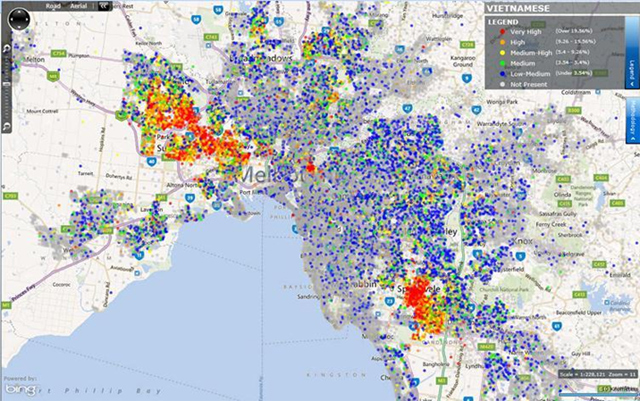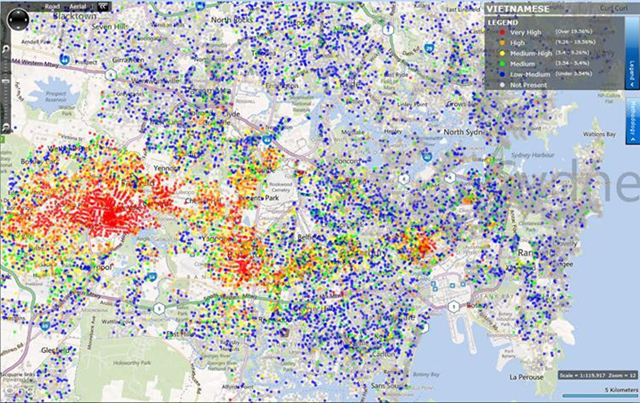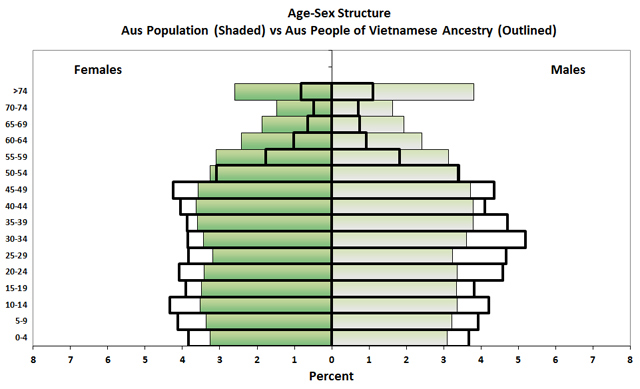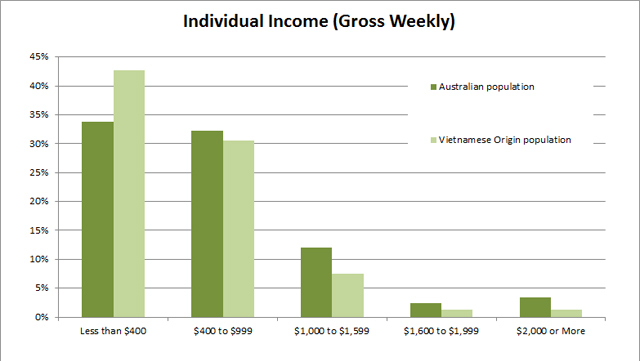Spotlight On … The Vietnamese Community in Australia
Background
Prior to 1975, the number of people in Australia of Vietnamese origin was under a thousand. The capture of Saigon by the Vietnam People’s Army in April 1975 precipitated an exodus of Vietnamese people, fearing for their lives and their futures.
In the ensuing decade, it is estimated that two million people fled Vietnam seeking refuge in other countries, with Australia being the second most popular destination after the USA.
In 1982, the Family Reunion Program, allowed families of Vietnamese migrants and refugees to reunite through a planned migration program, resulting in a second wave of migration. Overall, between 1975 and 1994, over 112,000 Vietnamese refugees were accepted for settlement in Australia.1
A well-established Vietnamese population and the appeal of a better lifestyle continue to make Australia an attractive destination for many Vietnamese seeking to study, work or live abroad.
The Vietnamese community is one of the largest cultural groups in Australia – after people from the United Kingdom, New Zealand, China and Italy. The 2006 census data indicates that Australia is home to 173,666 people of Vietnamese origin. The Origins database, representing people aged over 18, contains some 141,000 people with names that are of Vietnamese origin.
Vietnamese Names
It is estimated that almost 40% of Vietnamese people share the surname Nguyễn and more than 75% share six surnames – Nguyễn, Trần, Le, Pham, Huỳnh/Hoàng and Phan.2 Nguyễn became a common surname during the Tran Dynasty in the 11th to 13th centuries, with many of the courtesan families of the prior Lys dynasty changing their name to Nguyễn to avoid persecution. Nguyễn is the seventh most common surname in Australia (see Media Article ‘As Common As Nguyen‘).3
Vietnamese names generally consist of three parts: a family name, a middle name, and a given name, used in that order. Due to the prevalence of a small number of family names, a person is usually referred to by their middle name along with their given name. It is Vietnamese cultural practice for women to retain their family names when they marry and many Vietnamese have also adopted western names – particularly as personal names.
From the Origins database, almost a quarter of Vietnamese-Australians carry the name Nguyễn with another four – Trần, Huỳnh/Hoàng, Pham and Lam. This brings the proportion of people with one of the five most popular family names to 52%.
The vast majority (around 77%) of people with a name of Vietnamese origin live in New South Wales and Victoria, predominantly in Sydney and Melbourne.
The Origins database allows us to map the distribution of people with Vietnamese names at a very detailed level of geography – in this case, the newly-created Mesh Block unit containing an average of around 50 persons. The following map shows the how spatially concentrated the Vietnamese population is across Melbourne. Despite the majority of migrants having arrived more than thirty years ago, there has been limited dispersion from the initially settled core localities.

Source: Origins Database 2011
| Local Government Area | Proportion of Over 18 Population with Vietnamese Names |
| Maribyrnong | 12.19% |
| Greater Dandenong | 10.91% |
| Brimbank | 10.20% |
| Yarra | 7.51% |
| Moonee Valley | 3.07% |
Source: Origins Database 2011
Although the City of Maribyrnong has the highest concentration of people with Vietnamese names, the cities of Brimbank and Greater Dandenong have larger numbers.
The following map shows the distribution of the Vietnamese population in Sydney.

Source: Origins Database 2011
There is an even greater concentration in the Sydney metropolitan area – almost one in five people in the City of Fairfield has a Vietnamese name.
| Local Government Area | Proportion of Over 18 Population with Vietnamese Names |
| Fairfield | 19.00% |
| Bankstown | 7.68% |
| Auburn | 7.68% |
| Marrickville | 4.85% |
| Canterbury | 4.45% |
| Liverpool | 4.10% |
| Strathfield | 3.09% |
Source: Origins Database 2011
The Vietnamese Community in Australia: Market Characteristics
The census demographics (soon to be updated with 2011 census results) reinforce observations from the Origins database. Clearly, there is a NSW and Victoria emphasis although concentrations in South Australia and the ACT make them a significant minority in those jurisdictions.
| Australians of Vietnamese Origin by State/Territory | ||||||||||
| State | NSW | VIC | QLD | SA | WA | TAS | NT | ACT | Other | TOTAL |
| Vietnamese Origin |
65,886 | 63,638 | 15,803 | 12,493 | 11,844 | 173 | 715 | 3,106 | 3 | 173,666 |
| Australian Population4 |
6.55m | 4.93m | 3.90m | 1.51m | 1.96m | 0.48m | 0.19m | 0.32m | 0.00m | 19.86m |
| Vietnamese Proportion |
1.01% | 1.29% | 0.40% | 0.82% | 0.60% | 0.04% | 0.37% | 0.96% | 0.13% | 0.87% |
|
Source: Data generated using ABS TableBuilder: 2006 Census of Population and Housing
|
||||||||||
The following age-sex pyramid highlights the distinctive population structure of the Vietnamese community. Across Australia, Vietnamese are younger and, unusually, males markedly outnumber females in the 20 to 39 age groups when compared to the total Australian population. For this grouping the male:female ratio is 122 males for every 100 females.

Source: Data generated using ABS TableBuilder: 2006 Census of Population and Housing
The younger age profile is reflected in the comparative proportion of people aged 20-35 who are engaged in full time education. This also reflects the value placed on education and self-improvement by members of the Vietnamese community.
| Student Status: Australians of Vietnamese Origin vs Total Population – Aged 20-35 | |||
| Student status | Vietnamese Origin
Aged 20-35 |
Population
Aged 20-35 |
Vietnamese Index |
| Full-time Student | 16.91% | 10.82% | 156 |
|
Source: Data generated using ABS TableBuilder: 2006 Census of Population and Housing
|
|||
Reflecting the age profile and the higher than average proportion engaged in tertiary education it is not surprising that achievement levels in education among the Vietnamese in Australia are high. While the overall population holding a bachelor degree or higher is very similar between Vietnamese and the general population, the commitment of younger Vietnamese to education and qualifications is very clear for the 20-35 age cohort. The proportion of Vietnamese people holding a bachelor degree in this age group compared with the general Australian population indexes at 135.
| Education Levels: Australians of Vietnamese Origin vs Total Population | |||
| Highest Level of Education | Australia: Vietnamese origin | Australia: Population | Index |
| Bachelor Degree Level | 24.6% 11,198 |
18.2% 733,434 |
135 |
|
Source: Data generated using ABS TableBuilder: 2006 Census of Population and Housing
|
|||
Income levels among Australians of Vietnamese origin are lower compared with the total Australian population, with 44.5% of the Vietnamese population earning $400 or less per week – compared with 31.9% of the general Australian population. This pattern reflects the relatively large proportion of young Vietnamese students and people in the early stages of their career. However, based on 2006 individual income data from the census, the Vietnamese community still earns more than $3bn per year.

Source: Data generated using ABSTableBuilder: 2006 Census of Population and Housing
In reviewing Age-Sex structure, student status, education levels and income levels it is clear that a large number of this young population has some way to go to reach its earning potential – but the gap is closing and the Vietnamese in Australia represent an emerging segment for marketers to address. The population is increasingly educated and marketers who tailor their offer and target most effectively to the Vietnamese cultural context will be the winners.
Vietnamese Consumer Attributes and Attitudes
The Vietnamese share many of the cultural and retail preference characteristics with the Chinese, as reported in Edition 2 of OriginsInsight.
Religion underpins the belief system of Vietnamese-Australians with Buddhism and Catholicism being by far the two most popular religions – 58.6% of Vietnamese-born declared Buddhism as their religion at the 2006 Census and 22.1% declared being Catholic.4
Vietnamese people are also highly family-oriented, with many living as extended families – sometimes with several generations sharing a single household. The traditional Vietnamese family is patriarchal, with the mother considered the home administrator (“noi tuong”) with responsibility for family harmony, budgeting and schedules. The father is the family spokesperson and decision-maker in major family and household decisions. Men traditionally have a higher status than women, and sons are more highly valued than daughters. Family members are expected to work and act for the good of the entire family and children are expected to care for elderly parents. Benefit to family and community ranks higher in respect than any benefit to the individual.
More recently, Australians of Vietnamese origin have varied from the traditional extended family structure. A history of traumatic conditions in Vietnam combined with the influence of the host Australian culture is challenging traditional family structures, and most Vietnamese-Australian families now live in a nuclear family structure5 – although a significant number of Vietnamese people have no family in Australia and therefore limited family support.
Marketers should note that parents are likely to be the main decision-makers and many consumer purchases are likely to be made according to the benefit that the purchase will bring to the family rather than the individual. Vietnamese-Australian consumers are likely to be heavily influenced by family or friend recommendations.
Vietnamese culture places great stock in respect for authority, elders, and ancestors. In fact, insults to elders or ancestors often lead to becoming socially isolated. People are non-confrontational and avoid conflict to the extent that disagreement may be expressed in the form of non-compliance, or not answering a question. Politeness, modesty and privacy are respected cultural values that have significant implications for marketers seeking to engage with them.
Provocative, aggressive, immodest imagery will not be appropriate to reach this group. Humour and celebrity in advertising are appreciated but what might be considered as a glamorous model to the ‘mainstream’ culture can, at best, be perceived as an emaciated person or, worse, be offensive or indiscreet to some cultural groups, resulting in disengagement from the message and/or the brand.
On the other hand, messages that emphasise greater hope for the future are well received. Keeping ‘face’ is very important, and a good reputation is valued more highly than material possessions.
Vietnamese Consumer Behaviour
Market research shared by SBS describes a reach to the Sydney Vietnamese population that exceeds 50% for in-language print and radio. In-language TV has a reach of 29% in Sydney. Vietnamese shoppers greatly value fresh produce and prefer the market shopping experience.
Past analysis using Origins in a variety of contexts has revealed several consumer traits that characterise the Vietnamese consumer. Vietnamese shoppers are active participants in loyalty schemes – especially the under 35s. Although they underperform on the amount of spend and number of visits, they over-perform in their participation in discount events. They are bargain hunters and use negotiation to gain a sense of satisfaction in doing a ‘good deal’.
Vietnamese-Australians are 25% less likely to be involved in motoring organisations and 50% less likely to take roadside assistance. Participation in motor insurance is close to par but with a distinct gender bias to male. There is a disproportionate preference for visits to Australia Post or an organisation’s branches for payment of bills compared with more contemporary electronic means.
There is over-representation in some brands of superannuation membership and a slightly greater tendency to respond to co-contribution promotions. Attendance at formal cultural events such as theatre and musical concerts is very low, as is participation in elite sports.
Vietnamese-Australians in Victoria are 28% more likely not to vote in elections, although this is lower than other groups such as Chinese-Australians.
Origins analysis confirms that Vietnamese people are genetically more likely to contract hepatitis C and Vietnamese women are less likely to participate in breast screening programs, making them more susceptible to suffer from breast cancer.
1 http://www.mdaa.org.au/publications/ethnicity/vietnamese/general.html
2 https://en.wikipedia.org/wiki/Vietnamese_name
3 Nguyens Keeping up with the Joneses
4 According to the 2006 Census data
5 http://www.mdaa.org.au/publications/ethnicity/vietnamese/general.html